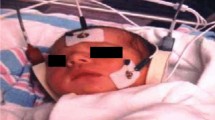Summary
We conducted a long-term study of 85 children with known transient neonatal hyperbilirubinemia to determine if their hearing had been affected. None of the children had neural symptoms such as kernicterus. The children ranged in age from birth to 9 months and were studied by means of brainstem evoked response audiometry (BERA). Thirty-four of the children were studied sequentially between 15 and 80 months after the initial examination. Our results showed that there was no significant correlation between serum bilirubin concentrations and BERA thresholds or latencies. These findings indicate that, unlike manifest cases of kernicterus, neonatal hyperbilirubinemia does not affect neonatal hearing when treated promptly.
Similar content being viewed by others
References
Ballowitz L (1980) Bilirubin encephalopathy: changing concepts. Brain 2:207–215
Ballowitz L, Dinshaw K, Keller P, Werner F (1984) Sieht man heute noch Folgen einer Neugeborenen-Hyperbilirubinämie? 10th Symposium on Pediatric Intensive Care, Berlin
Belal A Jr (1975) Effects of hyperbilirubinemia on the inner ear in Gunn rats. J Laryngol Otol 89:259–265
Buch NH, Tygstrup I, Jorgensen MB (1966) Erythroblastosis foetalis and the hearing organ. Acta Otolaryngol 61:387–397
Carhardt R (1967) Probable mechanisms underlying kernicterus hearing loss. Acta Otolaryngol [Suppl] 221:1–41
Chisin R, Perlman M, Sohmer H (1979) Cochlear and brain stem responses in hearing loss following neonatal hyperbilirubinemia. Ann Otol Rhinol Laryngol 88:352–357
Davis H, Yoshie N (1963) Human evoked cortical responses to auditory stimuli. Physiologist 6:164
Desplands PA, Galambos R (1980) Use of the auditory brainstem responses by prematures and newborn infants. Neuropediatrics 11:99–105
Fawer CL, Dubowitz LMS (1982) Auditory brain stem responses in neurologically normal preterm and fullterm newborn infants. Neuropediatrics 13:200–206
Gerull G, Giesen M, Mrowinski D, Rudolph N (1972) Untersuchung eines frühen, von der Kopfhaut ableitbaren Potentials für die objektive Audiometrie. HNO 20:339–343
Gerull G, Giesen M, Mrowinski D (1978) Quantitative Aussagen der Hirnstammaudiometrie bei Mittelohr-, kochleären und retrocochleären Hörschäden. Laryngol Rhinol 57:52–62
Goldstein PJ, Krumholz A, Felix JK, Shannon D, Carr RF (1979) Brainstem evoked responses in neonates. Am J Obstet Gynecol 135:622–631
Haymaker W, Margales C, Pentschew A (1961) Pathology of kernicterus and posticteric encephalopathy. In: Swinyard CA (ed) Kernicterus and its importance in cerebral palsy. Charles C. Thomas, Springfield, Illinois
Hsia DYY, Allen FH, Gellis SS, Diamond LK (1952) Erythroblastosis fetalis. VIII. Studies of serum bilirubin in relation to kernicterus. N Engl J Med 247:668–671
Kakaga K, Kitazumi E, Kodama K (1979) Auditory brain stem potentials in kernicterus infants. J Pediatr Otorhinolaryngol 1:255–264
Knüpling R, Fuchs EC, Stoltenburg G, Gerull G, Giesen M, Mrowinski D (1979) Chronic and transtentorial herniation with tumors of the posterior cranial fossa. Neurochirurgia 22:9–23
Lee KS, Gartner LM, Eidelman AI (1977) Unconjugated hyperbilirubinemia in very low birthweight infants. Clin Perinatol 4:305
Lehnhardt E (1981) The sound intensity-related behaviour of the brain stem response P6 in different forms of hearing disorders. Arch Otorhinolaryngol 232:203–213
Levi G, Sohmer H, Kapitulnik J (1981) Auditory nerve and brain stem responses in homozygous jaundiced Gunn rats. Arch Otorhinolaryngol 232:139–143
Matkin ND, Carhart R (1966) Auditory profiles associated with Rh incompability. Arch Otolaryngol 64:502–513
Picton TW, Hillyard SA, Krausz HI, Galambos R (1974) Human auditory evoked potentials. Electroencephalogr Clin Neurophysiol 36:179–190
Rudolph N, Mrowinski D, Giesen M, Gerull G (1974) Clinical experience with an early AER of 6–10 ms latency. Rev Laryngol 95:566–570
Schulman-Galambos C, Galambos R (1979) Brainstem evoked response audiometry in newborn hearing screening. Arch Otolaryngol 105:86–90
Yoshie N, Ohashie T (1969) Clinical use of cochlear and action potential responses in man for different diagnosis of hearing losses. Acta Otolaryngol [Suppl] (Stockh) 252:71–87
Author information
Authors and Affiliations
Rights and permissions
About this article
Cite this article
Thoma, J., Gerull, G. & Mrowinski, D. A long-term study of hearing in children following neonatal hyperbilirubinemia. Arch Otorhinolaryngol 243, 133–137 (1986). https://doi.org/10.1007/BF00453765
Received:
Accepted:
Issue Date:
DOI: https://doi.org/10.1007/BF00453765



